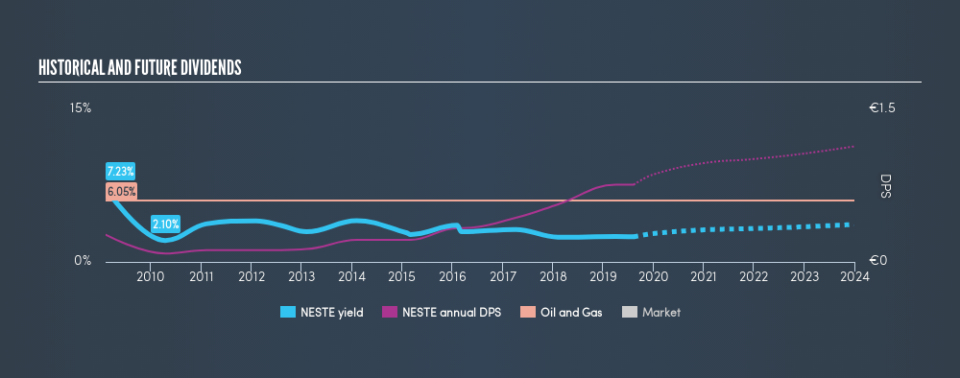How Does Neste Oyj (HEL:NESTE) Fare As A Dividend Stock?

Today we'll take a closer look at Neste Oyj (HEL:NESTE) from a dividend investor's perspective. Owning a strong business and reinvesting the dividends is widely seen as an attractive way of growing your wealth. Unfortunately, it's common for investors to be enticed in by the seemingly attractive yield, and lose money when the company has to cut its dividend payments.
A slim 2.5% yield is hard to get excited about, but the long payment history is respectable. At the right price, or with strong growth opportunities, Neste Oyj could have potential. There are a few simple ways to reduce the risks of buying Neste Oyj for its dividend, and we'll go through these below.
Explore this interactive chart for our latest analysis on Neste Oyj!
Payout ratios
Companies (usually) pay dividends out of their earnings. If a company is paying more than it earns, the dividend might have to be cut. Comparing dividend payments to a company's net profit after tax is a simple way of reality-checking whether a dividend is sustainable. In the last year, Neste Oyj paid out 66% of its profit as dividends. This is a fairly normal payout ratio among most businesses. It allows a higher dividend to be paid to shareholders, but does limit the capital retained in the business - which could be good or bad.
In addition to comparing dividends against profits, we should inspect whether the company generated enough cash to pay its dividend. Neste Oyj paid out 64% of its free cash flow last year, which is acceptable, but is starting to limit the amount of earnings that can be reinvested into the business. It's encouraging to see that the dividend is covered by both profit and cash flow. This generally suggests the dividend is sustainable, as long as earnings don't drop precipitously.
We update our data on Neste Oyj every 24 hours, so you can always get our latest analysis of its financial health, here.
Dividend Volatility
From the perspective of an income investor who wants to earn dividends for many years, there is not much point buying a stock if its dividend is regularly cut or is not reliable. For the purpose of this article, we only scrutinise the last decade of Neste Oyj's dividend payments. This dividend has been unstable, which we define as having fallen by at least 20% one or more times over this time. During the past ten-year period, the first annual payment was €0.27 in 2009, compared to €0.76 last year. This works out to be a compound annual growth rate (CAGR) of approximately 11% a year over that time. Neste Oyj's dividend payments have fluctuated, so it hasn't grown 11% every year, but the CAGR is a useful rule of thumb for approximating the historical growth.
Neste Oyj has grown distributions at a rapid rate despite cutting the dividend at least once in the past. Companies that cut once often cut again, but it might be worth considering if the business has turned a corner.
Dividend Growth Potential
With a relatively unstable dividend, it's even more important to see if earnings per share (EPS) are growing. Why take the risk of a dividend getting cut, unless there's a good chance of bigger dividends in future? Strong earnings per share (EPS) growth might encourage our interest in the company despite fluctuating dividends, which is why it's great to see Neste Oyj has grown its earnings per share at 11% per annum over the past five years. Neste Oyj's earnings per share have grown rapidly in recent years, although more than half of its profits are being paid out as dividends, which makes us wonder if the company has a limited number of reinvestment opportunities in its business.
Conclusion
To summarise, shareholders should always check that Neste Oyj's dividends are affordable, that its dividend payments are relatively stable, and that it has decent prospects for growing its earnings and dividend. Neste Oyj's is paying out more than half its income as dividends, but at least the dividend is covered by both reported earnings and cashflow. Unfortunately, the company has not been able to generate earnings per share growth, and cut its dividend at least once in the past. While we're not hugely bearish on it, overall we think there are potentially better dividend stocks than Neste Oyj out there.
Earnings growth generally bodes well for the future value of company dividend payments. See if the 16 Neste Oyj analysts we track are forecasting continued growth with our free report on analyst estimates for the company.
If you are a dividend investor, you might also want to look at our curated list of dividend stocks yielding above 3%.
We aim to bring you long-term focused research analysis driven by fundamental data. Note that our analysis may not factor in the latest price-sensitive company announcements or qualitative material.
If you spot an error that warrants correction, please contact the editor at editorial-team@simplywallst.com. This article by Simply Wall St is general in nature. It does not constitute a recommendation to buy or sell any stock, and does not take account of your objectives, or your financial situation. Simply Wall St has no position in the stocks mentioned. Thank you for reading.

 Yahoo Finance
Yahoo Finance 
